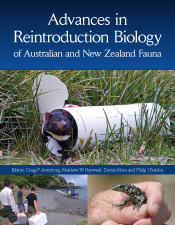Table of Contents
pp. v-vi
PDF (44 KB)
Table of Contents
pp. v-vi
PDF (44 KB)List of contributors
pp. vii-xi
PDF (64 KB)1 Introduction: the development of reintroduction biology in New Zealand and Australia
pp. 1-6
2 Release strategies for fauna reintroductions: theory and tests
pp. 7-16
3 Structured decision making for designing complex release strategies
pp. 17-27
4 The influence of predators and prey naivety on reintroduction success: current and future directions
pp. 29-42
5 Disease risk management in reintroduction
pp. 43-57
6 Considering dispersal in reintroduction and restoration planning
pp. 59-72
7 The roles of trials and experiments in fauna reintroduction programs
pp. 73-89
8 Advances in modelling projections for reintroduced populations
pp. 91-103
9 Proactive conservation or planned invasion? Past, current and future use of assisted colonisation
pp. 105-126
10 Conserving and enhancing genetic diversity in translocation programs
pp. 127-140
11 Metapopulation management of an extreme disease scenario
pp. 141-154
12 Using reintroduction to compensate for isolation in fragmented landscapes
pp. 155-165
13 Policy implications of ecosystem engineering for multiple ecosystem benefits
pp. 167-184
14 The impact of private sanctuary networks on reintroduction programs
pp. 185-199
15 Advances in the contribution of zoos to reintroduction programs
pp. 201-215
16 Forty years of fauna translocations in Western Australia: lessons learned
pp. 217-235
17 Underwater, out of sight: lessons from threatened freshwater fish translocations in Australia
pp. 237-253
18 Practical guidelines for planning and implementing fauna translocations
pp. 255-271
19 Evolution of the translocation approval process in Australia and New Zealand
pp. 273-284
20 Reintroduction biology of Australian and New Zealand fauna: progress, emerging themes and future directions
pp. 285-290
Index
pp. 291-303
PDF (122 KB)